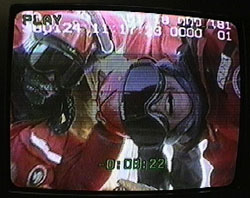
|

|
|
|
©
Per Olof Hulth
|
|
|
Looking
into the camera as others prepare to lower AMANDA's optical
modules into the ice.
|
|
|
|

A
literary essay about AMANDA by Francis Halzen
page 3
IN
THE PAST FOUR DECADES neutrino detectors of increasing scale
and sensitivity have cropped up in odd spots around the globe:
in an iron mine in Minnesota; underneath a mountain in Italy’s
Apennine range; in an abandoned railway tunnel on the outskirts
of Osaka, Japan. None of them are really telescopes, however:
rather than tracking high-energy neutrinos to map deep space,
as AMANDA does, they simply detect low-energy neutrinos from
the sun.
One might think that one or two solar neutrino detectors would
be enough. But a single mystery has continued to tantalize
investigators. According to standard astrophysical theory,
nuclear fusion inside the sun ought to spawn a stable number
of neutrinos, and so physicists ought to detect a predictable
number of them. Instead, month after month, in detector after
detector, no more than half of the expected neutrinos are
counted. Are the detectors faulty, or does solar astrophysics
need some revision? Neither one, most physicists now say.
The flux of solar neutrinos is too weak because the particles
transform themselves en route to the earth. What were once
electron neutrinos become their particulate cousins: muon
neutrinos and tau neutrinos, which most neutrino detectors
cannot detect.
The fact that neutrinos come in three "flavors"
is old and undisputed. But the idea that they oscillate between
those three flavors entails a fundamental rethinking of their
nature—and perhaps of the universe itself. According
to the standard model of elementary particle physics, neutrinos
have no mass at all. Yet according to quantum theory, only
particles with mass can oscillate between one flavor and another.
By recent estimates, there are about 100 million times as
many neutrinos in the universe as there are protons and neutrons
combined. Even if the mass of each neutrino is no more than
a tenth of an electron volt, their collective mass would be
as great as that of all the visible matter in the universe.
"Neutrino oscillations have been discovered at least
four times and undiscovered at least twice," notes the
particle physicist Donald H. Perkins of the University of
Oxford. Last June, however, physicists in Takayama, Japan,
announced results that have silenced most of the remaining
doubters. Their Super-Kamiokande detector, built in a working
zinc mine a kilometer underground, incorporates more than
13,000 photomultipliers to survey 50,000 tons of water for
telltale flashes of light. (A photomultiplier looks like a
lightbulb and works like a lightbulb in reverse: light goes
in and electricity comes out. But what a lightbulb! The photomultipliers
in Super-K amplify signals by a factor of 100 million.)
|
